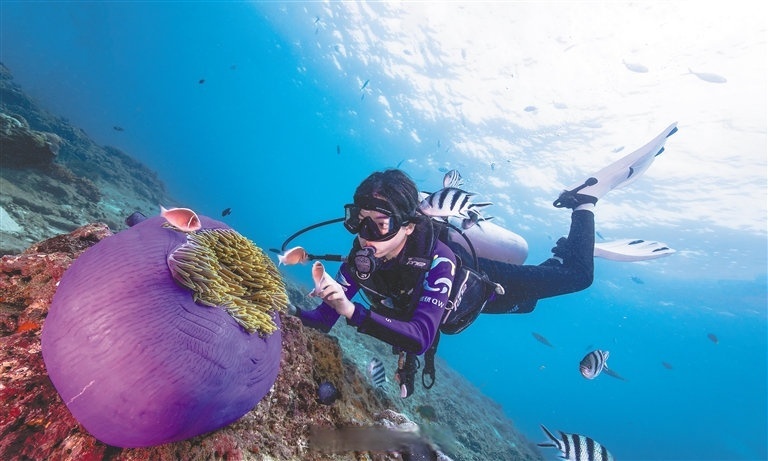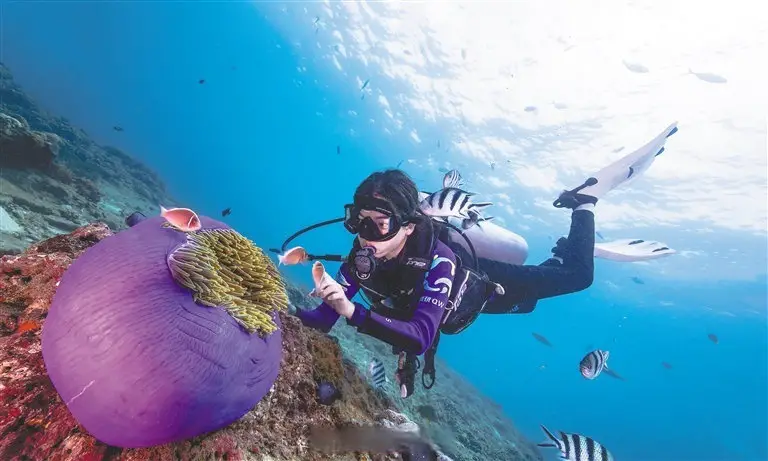By Cao Wenxuan, People's Daily

The underwater "afforestation" relies on technological progress. There are large areas of coral reefs under the sea waters around Hainan province, which makes the province a major planter of corals. Coral reef restoration technologies have been constantly improved during the coral planting practice in the province.
Coral reefs are among the oldest and most valuable ecosystems in the world. They are home to nearly 30 percent of marine species though they cover only less than two thousandth of the ocean floor.
However, global warming, marine pollution and over excavation have constantly degraded coral reefs in the last 20 years. Therefore, Chinese marine biologists are planting corals on the seabed to protect coral reefs and restore marine ecology.
Thanks to their efforts, scuba divers are now able to see a vibrant undersea world where species of fish swim in between swaying colorful corals in the waters around Wuzhizhou Island, a renowned tourist attraction in Sanya, south China's Hainan province.
It's beyond imagination that 10 years ago, in this vibrant undersea world, there were only shipwrecks and cement piles. The coral reef ecosystem in the waters near Wuzhizhou Island was once destroyed due to the warming seawater, fishing and coastal construction.
Under years of efforts made by scientific researchers, 30,188 corals have been planted on the seabed around Wuzhizhou island, which covers around 50,000 square meters. The undersea "afforestation" efforts are leading to constant improvement of the marine ecosystem. Coral planting has even been made into a scuba diving program for tourists visiting the island since this year.
Since 2013, Sanya has implemented 19 projects to restore marine ecology, including the restoration of coral reefs and shoals, as well as shoreface nourishment. The city has restored 7.7 kilometers of coastline and a sea area of 51,584 square meters.
Coral planting is a harder form of "afforestation." On one hand, the complicated marine environment creates huge challenges for planting activities, such as the fierce flow of sea water in the South China Sea caused by typhoons between July and October each year; on the other hand, sections of the seabed are differently affected by the environment and human disturbance, and their health levels also vary, so it calls for scientific researchers to make individualized plans.
The underwater "afforestation" relies on technological progress. There are large areas of coral reefs under the sea waters around Hainan province, which makes the province a major planter of corals. Coral reef restoration technologies have been constantly improved during the coral planting practice in the province.
For instance, the Hainan South China Sea Institute of Tropical Ocean has improved the efficiency of coral planting by applying a stainless steel seedbed; Hainan University has made new breakthroughs in the restoration of fractured coral reefs by combining artificial fish reefs and coral reef restoration.
New methods and technologies are driving new progress in China's underwater "afforestation" and contributing Chinese wisdom to the global protection of the marine ecosystem.
Artificial methods are just a supplement to the restoration, while the reduction of human disturbance remains the key to bettering the marine ecosystem.
In recent years, China has enhanced its efforts to promote natural restoration of coral reefs, and coral reef protection has been included in a series of laws of the country.
Besides, China has joined the Convention on Biological Diversity, the Convention on International Trade in Endangered Species of Wild Fauna and Flora, as well as other international treaties.
The country has established five state- and province-level nature reserves and a special national ocean park involving coral reefs.
So far, nearly 30 percent of the offshore waters and 37 percent of the continental coastline of China have been incorporated into its ecological red lines, which is making the ocean more and more beautiful.
However, global warming, marine pollution and over excavation have constantly degraded coral reefs in the last 20 years. Therefore, Chinese marine biologists are planting corals on the seabed to protect coral reefs and restore marine ecology.
Thanks to their efforts, scuba divers are now able to see a vibrant undersea world where species of fish swim in between swaying colorful corals in the waters around Wuzhizhou Island, a renowned tourist attraction in Sanya, south China's Hainan province.
It's beyond imagination that 10 years ago, in this vibrant undersea world, there were only shipwrecks and cement piles. The coral reef ecosystem in the waters near Wuzhizhou Island was once destroyed due to the warming seawater, fishing and coastal construction.
Under years of efforts made by scientific researchers, 30,188 corals have been planted on the seabed around Wuzhizhou island, which covers around 50,000 square meters. The undersea "afforestation" efforts are leading to constant improvement of the marine ecosystem. Coral planting has even been made into a scuba diving program for tourists visiting the island since this year.
Since 2013, Sanya has implemented 19 projects to restore marine ecology, including the restoration of coral reefs and shoals, as well as shoreface nourishment. The city has restored 7.7 kilometers of coastline and a sea area of 51,584 square meters.
Coral planting is a harder form of "afforestation." On one hand, the complicated marine environment creates huge challenges for planting activities, such as the fierce flow of sea water in the South China Sea caused by typhoons between July and October each year; on the other hand, sections of the seabed are differently affected by the environment and human disturbance, and their health levels also vary, so it calls for scientific researchers to make individualized plans.
The underwater "afforestation" relies on technological progress. There are large areas of coral reefs under the sea waters around Hainan province, which makes the province a major planter of corals. Coral reef restoration technologies have been constantly improved during the coral planting practice in the province.
For instance, the Hainan South China Sea Institute of Tropical Ocean has improved the efficiency of coral planting by applying a stainless steel seedbed; Hainan University has made new breakthroughs in the restoration of fractured coral reefs by combining artificial fish reefs and coral reef restoration.
New methods and technologies are driving new progress in China's underwater "afforestation" and contributing Chinese wisdom to the global protection of the marine ecosystem.
Artificial methods are just a supplement to the restoration, while the reduction of human disturbance remains the key to bettering the marine ecosystem.
In recent years, China has enhanced its efforts to promote natural restoration of coral reefs, and coral reef protection has been included in a series of laws of the country.
Besides, China has joined the Convention on Biological Diversity, the Convention on International Trade in Endangered Species of Wild Fauna and Flora, as well as other international treaties.
The country has established five state- and province-level nature reserves and a special national ocean park involving coral reefs.
So far, nearly 30 percent of the offshore waters and 37 percent of the continental coastline of China have been incorporated into its ecological red lines, which is making the ocean more and more beautiful.
 Menu
Menu
 Sanya in S China sees steady progress of coral reef protection
Sanya in S China sees steady progress of coral reef protection
















